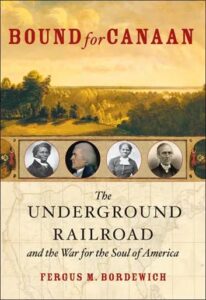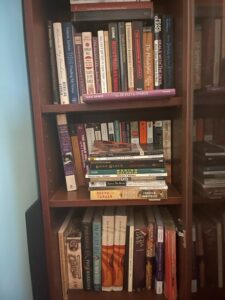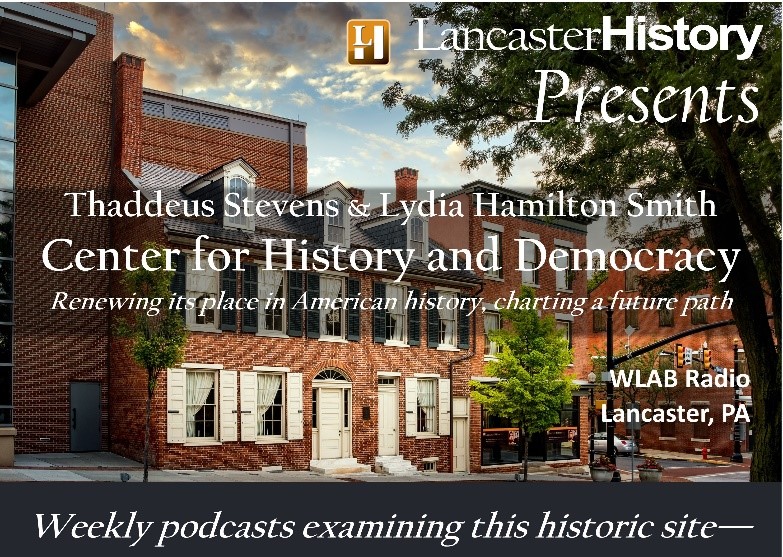At the start of 2022, just as I had completed my retirement from AT&T (following 28 years there), taken 1 month off and then started a new role leading sales and marketing for Sequential Technologies, Inc, I received a call from a longtime associate in the world of history, Randy Harris.
We’d met early in my history hunting career when he’d outreached to me over the discovery of Oliver Gilbert’s unpublished autobiography.
In 2010, Randy was then working as a historian and researcher for Lancaster County Historical Society, now Lancaster History, to certify that Thaddeus Stevens had been conducting abolitionist activity from his office at 45 Queen Street in Lancaster, Pennsylvania. He was at the helm of the application to the US government’s Department of Interior to obtain the coveted designation as a ‘Network to Freedom’ site, certifying underground railroad activity from the location.
The Network to Freedom program of the US Department of Interior currently contains over 740 locations nationwide with a verifiable connection to the Underground Railroad. These locations include sites, facilities and programs, most of which can be visited. More information can be found here – Underground Railroad (U.S. National Park Service) (nps.gov)
Thaddeus Stevens was a Radical Republican leader and one of the most powerful members in the U.S. House of Representatives. He focused much of his political attention on civil rights, eventually helping to draft the 14th Amendment and dominated the House during Reconstruction and proposed the impeachment of President Andrew Johnson.
According to Oliver Gilbert, it Thaddeus Stevens to whom Oliver was directed upon reaching first reaching freedom’s soil, Lancaster, PA and it was Thaddeus who was the first abolitionist to welcome Oliver and the 14 other freedom seekers into his home, to his dinner table, and to his wagon for safe passage.
Here is the passage –
‘This was Wednesday about 9am. The first we had eaten since we left, except the corn. That was all the money we had. We arrived at Lancaster about noon. We were directed to call at No. 45 South Queen Street and we would find a lawyer, who was a friend to the slaves. We moved very cautiously towards his place. He said “what can I do for you”? Ben said “we are looking for work and we heard dat you gave work to colored people”. “How far have you come” asked Stevens. “Right smart ways sir”, replied Ben. “Can you walk several miles further”? said he. “Yes sir”! “Well, you take this note and go to Bird-in-hand and give it to Daniel Gibbons and I think he will find you work. Just before you get into the village you will see a white painted house sitting back in the field, then up a lane and ask for Daniel Gibbons and give him this note”. Up the turnpike we went that Wednesday afternoon’.
Randy’s Network to Freedom application had been previously denied. He had a tight window in which to revise it for resubmission with additional documentation – and along came Oliver, via me, with the above passage and all of the other verifiable evidence of Oliver’s freedom trail. Randy and I danced around the need for copies of the pages from the memoir. I was skeptical, as I’d been warned about ‘giving away’ our family’s story to opportunists who’d recognize it for its value in the literary or collectible market. Randy offered to compensate me, and I declined. In the end, I decided to help Lancaster, PA in the way Lancaster had helped our family – by leveraging our knowledge and network to secure a legacy. Randy proved to be a steadfast supporter of the legacy of Oliver Gilbert and my desire to learn and grow in the field. Soon thereafter, he incited me to my first UGRR conference in Washington DC and introduced me around.
I provided the pages, a release for us, and my own submitted letter to the Underground Railroad Network to Freedom, which is all visible on their website.
The application was approved. The office of Thaddeus Steves is now a recognized Underground Railroad site and grant dollars have been secured to complete a $9M restoration and museum. Thank you, Oliver Gilbert.
Okay, now that you are grounded on the backstory of my relationship with Randy Harris and his relationship with Thaddeus Stevens – I’ll explain why he called in 2022.
Randy was planning to product a podcast on the Thaddeus Stevens site. It was to be audio and video recorded, and for use later in the museum, as well as released on community radio. That was exciting and I was eager to participate; but what was MOST exciting was that I would be a panelist with Fergus Bordewich!
Immediately upon seeing his name on the lineup, I glanced at my bookshelf – and there it was….’Bound for Canaan’, a book I’d enjoyed several years earlier and had repeatedly referenced in the quest to understand the self-liberation of those who had been enslaved. Bound for Canaan was selected as one of the American Booksellers Association’s “ten best nonfiction books” in 2005; as the Great Lakes Booksellers’ Association’s “best non-fiction book” of 2005; as one of the Austin Public Library’s Best Non-Fiction books of 2005; and as one of the New York Public Library’s “ten books to remember” in 2005.
In my mind, Fergus is ROYALTY! And I was going to podcast with him? Unreal!
Fergus Bordewich has been an independent historian and writer since the early 1970s. He is a frequent book reviewer for The Wall Street Journal and other popular and scholarly periodicals, mostly on subjects in 18th and 19th century American history. He wrote the script for a PBS documentary about Thomas Jefferson, Mr. Jefferson’s University.

Fergus Bordewich
Summary of Bordewich’s publications –
- Klan War: Ulysses S. Grant and the Battle to Save Reconstruction (Knopf, 2023)
- Congress at War: How Republican Reformers Fought The Civil War, Defied Lincoln, Ended Slavery, And Remade America (Penguin Random House, 2020)
- The First Congress: How James Madison, George Washington, and a Group of Extraordinary Men Invented the Government (Simon & Schuster, 2016)
- America’s Great Debate: Henry Clay, Stephen A. Douglas, and the Compromise That Preserved the Union (Simon & Schuster, 2012)
- Washington: The Making of the American Capital (Amistad/HarperCollins, 2008)
- Bound for Canaan: The Underground Railroad and the War for the Soul of America (Amistad/HarperCollins, 2005)
- My Mother’s Ghost, a memoir (Doubleday, 2001)
- Killing the White Man’s Indian: Reinventing Native Americans at the End of the Twentieth Century (Doubleday, 1996)
- Cathay: A Journey in Search of Old China (Prentice Hall Press, 1991)
And here we were, in February 2022, gathered on Zoom to podcast for the Thaddeus Stevens and Lydia Hamilton Smith Center for History and Democracy.
Randy opened with:
Welcome to Episode 5 of The Stevens & Smith Podcast, a weekly series of discussions with scholars, community historians and project team leaders. In today’s episode, we will be discussing The Underground Railroad – National and & regional events and the involvement of Thaddeus Stevens (1792-1868) and Lydia Hamilton Smith (1815-1884) at their Lancaster properties and elsewhere; involvement in regional UGRR activities by their associates and others involved in anti-slavery activity.
Following the lively podcast, I traded emails with Fergus and sent him a photo of my bookshelf with Bound for Canaan clearly displayed.
He replied:

Bound for Canaan on the Shelf
“How kind of you to tag my book, Stephanie – and to keep it in such good literary company! I’m glad that it has been of use to you. I’ve been heartened over the years to hear of it encouraging people to undertake UGRR research in their own communities”.
Below are the suppositions created for the discussion. Your insight is always welcome!
BACKGOUND:
Here are known incidents, suppositions and circumstantial evidence about the involvement of Stevens & Smith and some of their associates in the Underground Railroad Movement, c. 1830 through early 1860s. You are welcome to add to this information, dispute it or otherwise challenge these points:
- Supposition: Early 1830s. Stevens as PA Representative and member of the Canal Commission, responsible for patronage jobs for people sympathetic to the Abolitionist cause on the Main Line of Public Works, which was eventually a major transportation corridor for freedom seekers moving both east and west across Pennsylvania;
- Supposition: 1830s through 1850s. Stevens, as owner of the Caledonia Iron Furnace in Franklin County, PA, and large acreage of adjoining woodlands, a short distance west of his home and office in Gettysburg, Adams County, PA, is known to have employed a great many African men. Black families settled in relatively large numbers nearby. Stevens’ furnace superintendent is reported to have provided shelter and employment to freedom seekers during this period, who lived among the settlement of free families of color. These action by his superintendent gave Stevens a means of plausible deniability regarding these illegal arrangements, if they had been disclosed.
- Supposition: 1838-1840. Author and Underground RR operative, Civil War veteran, Samuel Evans first discloses (in a news article in May 1870) that Smith and Whipper, in collaboration with William Wright of Columbia, in 1838, devised the installation of secret compartments in the S&W lumber freight cars, allowing an eight-hour trip from Columbia to relative freedom in Philadelphia. By 1840, with rail lines extended to York, PA, William C. Goodridge began a similar secret transport system with his privately owned freight railcars heading east. Mrs. Smith was associated with the Goodridge Family in some fashion, given her bequests to family member living in Saginaw MI by the later 19th
- Supposition: 1843-Stevens buys and rents a property on Front Street, Columbia, Lancaster County PA, almost immediately on his move to Lancaster City from Gettysburg. This area directly faces the Susquehanna River and lies opposite the Columbia & Wrightsville Bridge landing. It was a place of concentrated UGRR safe houses, with several properties adjoining Stevens’ owned by Stephen Smith and across the street from Smith’s and William Whipper’s lumber yard.
- Incident, August, 1848 – Visit to Stevens & Smith home and office by Oliver Cromwell Gilbert, his brother Ben and others, whom Stevens gives directions to the next safe house, the farm of Daniel and Hannah Gibbons six miles away. Documentation of this incident provided the evidence that Stevens, and presumably Mrs. Smith who was employed as Stevens housekeeper by then, supported the movement of freedom seekers on and in their property.
- Supposition: 1883 – The Lydia Hamilton Smith interview with Ellwood Griest and a separate account by his son, William Walton Griest, (shown as “WWG” at the end of his column) published, respectively within a few weeks of each other, in The Lancaster Inquirer and The Philadelphia Times, in October 1883, just 3 ½ months before Mrs. Smith died. These encounters between Mrs. Smith and two journalist who were sympathetic to her and Stevens’ personally and politically, appear to be the genesis of the most solid evidence of Stevens’ actions in support of the Underground Railroad Movement in Lancaster County, as follows:
- Evidence: Published in The Lancaster Inquirer, within the same month – on October 27, 1883 – as the LHS interviews, the “heretofore unpublished letter” which revealed that Stevens paid informants to spy on the actions of bounty hunters tracking the formerly enslaved in Lancaster City and County. This letter was placed in the public record by Smith and Stevens’ long-time associate and supporter, Ellwood Griest (1824 – 1900), Editor/Publisher of The Lancaster Inquirer, a staunch Republican newspaper. Publication of this letter (a copy of which has not yet been found) led to a flurry of articles in local and national newspapers, which provided more details about these activities. These activities have been reported in early 20th century news articles and referenced in some of Stevens’ biographies, but the original source has never been documented/referenced, only the subsequent reprints. And never has there been any substantive examination of this chain of events to reach consensus on the origin of the expository letter nor the motivation by Griest for first publishing it.

